- Quick Read
- Deep Read ( 6 Min. )

Why is Christian Science in our name?
Our name is about honesty. The Monitor is owned by The Christian Science Church, and we’ve always been transparent about that.
The Church publishes the Monitor because it sees good journalism as vital to progress in the world. Since 1908, we’ve aimed “to injure no man, but to bless all mankind,” as our founder, Mary Baker Eddy, put it.
Here, you’ll find award-winning journalism not driven by commercial influences – a news organization that takes seriously its mission to uplift the world by seeking solutions and finding reasons for credible hope.
Explore values journalism About usMonitor Daily Podcast
- Follow us:
- Apple Podcasts
- Spotify
- RSS Feed
- Download
TODAY’S INTRO
The importance of looking for hope
 Mark Sappenfield
Mark Sappenfield
The news overnight from Gaza was numbingly bleak. Another Israeli airstrike hit the Jabaliya neighborhood. The Wall Street Journal declares, “Israel’s New Calculus: Strike Hamas Harder Than Ever.”
But veteran journalist-turned-professor Dan Kennedy also posted about the war. He wrote that there is “so much legitimately terrible news that it’s hard to be optimistic about the prospects for peace and justice. Yet it’s important that we try.”
Then he talked about the Monitor. He even had his class listen to our podcast and told them to look for other stories of hope. It’s worth a read.
Share this article
Link copied.

Help fund Monitor journalism for $11/ month
Already a subscriber? Login

Monitor journalism changes lives because we open that too-small box that most people think they live in. We believe news can and should expand a sense of identity and possibility beyond narrow conventional expectations.
Our work isn't possible without your support.
Why Israel’s Netanyahu faces rising anger and distrust
In times of war, nations normally rally around their leader. But in Israel, Prime Minister Benjamin Netanyahu’s numbers are plummeting. The anger people felt before the war over a series of controversial moves has not dissipated. That’s uncharted territory. But something fascinating is happening instead. Israelis are rallying around one another.

-
By Neri Zilber Contributor
This past week Israeli Prime Minister Benjamin Netanyahu did something he hadn’t done for months: take questions from the local media. It was only the latest in a string of signs that the country’s longest-serving premier is under immense political strain.
As expected, much of the questioning by the gathered press Saturday night focused on Mr. Netanyahu’s continued refusal to take responsibility for lapses that preceded Hamas’ brutal Oct. 7 attack. Israel’s security chiefs have all publicly shouldered blame, but Mr. Netanyahu deflected questions about his role.
As public anger grows over what many Israelis say is inadequate government support after the attack, faith is declining in a leader who long presented himself as the one to trust on Israel’s security. Relatives of those being held hostage in Gaza are also increasing their campaign for the return of their loved ones, demanding the government prioritize that above its war aim of “destroying” Hamas.
Chaim Peri, a farmer and peace activist, was seized from Kibbutz Nir Oz and is now a hostage. His son, Lior, is adamant that the government “pay any price” to return the captives.
“The trust between us and the government has been completely shattered,” Lior Peri says. The only ray of hope? “It’s only the citizens that are running the country now, not the government. I believe in the power of my people.”
Why Israel’s Netanyahu faces rising anger and distrust

This past week Israeli Prime Minister Benjamin Netanyahu did something he hadn’t done for months: take questions from the local media.
It was only the latest in a string of signs that the country’s longest-serving premier is under immense political strain after Hamas’ brutal Oct. 7 attack and the outbreak of war in Gaza.
As expected, much of the questioning by the gathered press Saturday night focused on Mr. Netanyahu’s continued refusal to take responsibility for lapses that preceded the devastating assault, which claimed the lives of 1,400 Israelis, the vast majority civilians, and led to Hamas’ seizure of over 200 hostages.
All of Israel’s security chiefs have publicly shouldered blame for an event considered the worst intelligence and military failure in the country’s history. But when queried about his own role, Mr. Netanyahu, as he has done for weeks, said simply, “After the war everyone will have to give answers, myself included.”
Such deflection is a sign, analysts maintain, that he intends to fight to retain his post as public anger grows – with not only the Hamas attack but also its aftermath, including what many Israelis say is inadequate government support and assistance.
Relatives of those Israelis being held hostage in Gaza are also increasing their public campaign for the return of their loved ones, demanding the government prioritize that above even its war aim of “destroying” Hamas.
Beyond public anger appears to be declining faith, too, in a leader who long presented himself as the one to trust on Israel’s security.
In a recent poll by the Israel Democracy Institute, 55% of Jewish Israelis said they trusted the heads of the military more than Mr. Netanyahu to conduct the war, with only 7% preferring Mr. Netanyahu. Even among his right-wing base of support, only 10% of respondents said they trusted the prime minister more than the military chiefs.
Much is at stake. Israel says 19 of its soldiers have been killed this week in ground combat against Hamas in Gaza, while the toll among Palestinians has been put at some 9,000 since Oct. 7. Exchanges of fire with Hezbollah are persisting in the north, and violence has been raging in the West Bank.

“Netanyahu suffered an extremely big [political] blow on Oct. 7,” says Tal Shalev, chief political correspondent for Walla News. “Just like the war itself, his political future is also shrouded in ‘fog’ and uncertainty. But it’s likely a fantasy, for now, to replace him mid-war.”
The blow Mr. Netanyahu suffered is unmistakable. An opinion survey released last weekend by the Maariv daily showed his Likud party cratering in the polls, losing over a third of its support. For the first time ever, Benny Gantz, a centrist opposition rival and former military chief, surpassed him by 20 points on the question of suitability to be prime minister.
In a sign of both national unity and urgent need, Mr. Gantz and his party joined Mr. Netanyahu’s coalition in an “emergency government” early last month and are helping lead the war against Hamas. By every metric, analysts say, Mr. Netanyahu hasn’t been this unpopular in over 15 years.
Yet he is attempting to fight back – though often with mixed results.
In yet another press conference this week with the foreign media, a tired-looking Mr. Netanyahu was asked directly if he would consider resigning.
“The only thing that I intend to have resign is Hamas. We’re going to resign them to the dustbin of history,” the usually loquacious prime minister responded flatly. “This is my responsibility now.”
Deflecting blame, then apologizing
A few days prior, however, Mr. Netanyahu issued a late-night post on social media attacking his own security chiefs for the failures of Oct. 7. By morning, Mr. Gantz and other leading politicians demanded he retract the message, widely viewed as both shameful and harmful in the midst of war.
Mr. Netanyahu relented, deleting the post and then issuing a rare apology.
“This is part of his battle to frame the narrative and survive, placing the entire blame on the defense establishment. He and his people are working on it constantly,” says Ms. Shalev, who adds that selective assessments from past security briefings are already being leaked to the media in a bid to make Mr. Netanyahu look better.
After the initial shock of Oct. 7, Mr. Netanyahu was rarely seen publicly, although he now appears to have regained his political footing, taking pictures with soldiers in the field and meeting with select groups of hostages’ families. But he has yet to venture out to meet the public at large, and likely for good reason.
Wednesday night, on prime-time television, Tamir Idan, head of the Sdot Negev Regional Council near the Gaza border, publicly announced his resignation from the Likud.
In a letter directly addressed to Mr. Netanyahu that he read on-air, Mr. Idan blasted the government for the lack of support to his residents, forced from their homes in the wake of the Hamas assault and the ongoing rocket fire into southern Israel.
Over 1,000 residents, Mr. Idan said, were in hotels across the country, funded not by the government but by private donations and foundations.
“I call here on all my friends, members of the Likud Central Committee, to take a similar step, in view of this incredible failure,” he added.

Nearly a month after the outbreak of hostilities, with an estimated 200,000 Israelis from the south and north displaced, and with an economy severely impacted by the call-up of hundreds of thousands of reservists, the government has yet to fully spring into action.
Multiple business owners and regular employees affected by the war have yet to receive any financial assistance or benefits, despite Mr. Netanyahu’s vows last week to “dig deep into our pockets.”
On Tel Aviv’s trendy Dizengoff Street this week, Pankina, an Italian restaurant, was bustling with activity, but not customers. Two dozen people were cutting up vegetables and fruit, preparing meals for soldiers, and soliciting donations for the war effort. Shlomo, an Italian Jewish immigrant and close friend of the restaurant owner, was coordinating.
“Everyone here is a volunteer, and the only money we receive are either from donations or charities. The government isn’t involved,” he says. “The restaurant hasn’t received any government support and neither has the staff. No one knows when they’ll be back at work, if at all, because no one knows how long this war will go on for.”
“Pay any price” for hostages
Most impacted are the families of those still languishing in captivity. As the days pass, apprehension for their loved ones grows.
Posters with the faces of those missing, with the blaring headline “Kidnapped,” appear on every street corner across the country. The entire facade of the Tel Aviv Municipality has scrolling giant text that reads, “Bring Them Home Now!”
Chaim Peri, a farmer and peace activist in his late 70s, was seized from Kibbutz Nir Oz on the morning of Oct. 7 and is now a hostage. His son, Lior Peri, a Netanyahu critic even before that traumatic day, is adamant that the premier and his government do everything – and “pay any price” – to return his father and all the other captives.
“The trust between us and the government has been completely shattered,” Lior Peri says. “My message to Netanyahu is simple: These are Israeli citizens, and they’re your responsibility.”
The only ray of hope during this difficult period, he adds, is the incredible outpouring of strength and solidarity from Israeli society.
“It’s only the citizens that are running the country now, not the government. I believe in the power of my people. It’s changed me.”
Whether the Israeli people force Mr. Netanyahu from power is uncertain, and will likely have to wait until the conclusion of the war, says Ms. Shalev, the political correspondent.
Israel has a long history of disposing of its leaders after major military reversals. Yet Mr. Netanyahu, for now, appears safe to try to win this war. After it ends, can he survive?
“So many things have happened under [Mr. Netanyahu] that never happened before; we just don’t know,” she says.

Russia’s nuclear saber rattling: Threat or wake-up call?
Does it matter that Russia has pulled away from a nuclear test ban treaty that the U.S. never ratified? That’s unclear. But Moscow’s increasingly bellicose talk about nuclear weapons has come with a realization, some say. The dialogue and deterrence of the Cold War era is worth trying to revive.

- Quick Read
- Deep Read ( 5 Min. )
The perception of threat from a massive, world-destroying nuclear war evaporated after the Soviet Union collapsed in 1991. But few have paid attention in recent years as the entire framework of strategic arms control, assembled over decades by Moscow and Washington, has been dismantled piece by piece by U.S. and Russian politicians.
The last important agreement, the Comprehensive Nuclear-Test-Ban Treaty, effectively lapsed when Russian President Vladimir Putin signed off Thursday on legislation to cancel Russia’s ratification of the deal. To leave no doubt that the Kremlin was sending a nuclear war-themed message to the West, late last month Russia’s strategic forces staged a major exercise, overseen by Mr. Putin, simulating a “massive retaliatory strike” against the United States.
Tensions have been rising in the East-West confrontation for several years, even as the diplomatic guardrails have fallen away. But experts say Russia’s increasingly intense nuclear saber rattling in recent months is less a call to confrontation than a wake-up call about deterrence.
“The point of all these signals is to move the U.S. elite out of its comfort zone, this belief that they can wage hybrid war against Russia without facing any real consequences,” says Dmitry Suslov, a foreign policy expert with the Higher School of Economics in Moscow.
Russia’s nuclear saber rattling: Threat or wake-up call?

The nuclear nightmares that kept the Cold War generation awake at night – and has been slumbering for decades – might return with a jolt.
The perception of threat from a massive, world-destroying nuclear war evaporated after the Soviet Union collapsed in 1991. But few have paid attention in recent years as the entire framework of strategic arms control, assembled over decades by Moscow and Washington, has been dismantled piece by piece by American and Russian politicians, leaving a dangerous vacuum where mutual responsibility, verification, and dialogue used to be.
The last important agreement, the Comprehensive Nuclear-Test-Ban Treaty, effectively lapsed when Russian President Vladimir Putin signed off Thursday on legislation to cancel Russia’s ratification of the deal. To leave no doubt that the Kremlin was sending a nuclear war-themed message to the West, late last month Russia’s strategic forces staged a major exercise, overseen by Mr. Putin, featuring a barrage of missile launches designed to simulate a “massive retaliatory strike” to counter a hypothetical attack on Russia from the United States.
Tensions have been rising in the East-West confrontation for several years, even as the diplomatic guardrails have fallen away. But experts say Russia’s increasingly intense nuclear saber rattling in recent months is less a call to confrontation than a wake-up call about the need to restore deterrence.
The Kremlin is deeply frustrated with Washington’s support for Ukraine, which includes not only arms and funding but also, Russian analysts contend, direct and escalating U.S. involvement in planning military operations, from target selection to assassinations. They argue that such U.S. involvement amounts to a proxy war against Russia, ignoring all Moscow’s “red lines.” Mr. Putin’s nuclear diplomacy, analysts say, may be a way to express distress while suggesting to U.S. officials that they may be courting nuclear war.
“The point of all these signals is to move the U.S. elite out of its comfort zone, this belief that they can wage hybrid war against Russia without facing any real consequences,” says Dmitry Suslov, a leading foreign policy expert with the Higher School of Economics in Moscow. “It’s clear from listening to things American leaders say, such as ‘supporting Ukraine is a good investment because Russians are getting killed and Americans aren’t,’ that they feel it’s a safe course of action. It is not safe. There is an escalatory ladder here, and very dangerous consequences are looming.”

The new context
Mr. Suslov says that Russia has been signaling its concern for some time, suspending its compliance with the nuclear START accord earlier this year, for example, forward-deploying Russian nuclear weapons to neighboring Belarus, withdrawing from the test ban treaty, and running increasingly aggressive nuclear drills.
“So far these are just words, messages, warnings, but that can change,” Mr. Suslov says. “We need to reestablish fear, make the U.S. afraid that it can happen. Russia believes that when the U.S. elite realizes that the danger of nuclear war is real – as was the case during the Cuban missile crisis – they will reconsider their policies.”
Russia has so far refrained from any step that would irrevocably change the status quo. Dropping ratification of the test ban treaty merely puts it on a par with the U.S., which never ratified the accord. Mr. Putin has said that Russia will not resume testing of nuclear weapons as long as the U.S. doesn’t start.
But in the present atmosphere, the Russian move sharply escalates tensions, says Vladimir Dvorkin, a military expert at the official Institute of World Economy and International Relations, a research university in Moscow.
“As a single action, this would not have caused any danger of using nuclear weapons, but it became another step in a chain of successive events and statements in Russia and the U.S. in conditions of fierce competition,” he says. “According to many politicians and experts, the threat of nuclear war is significantly increasing. This is facilitated by radical experts and new politicians, who advocate the actual use of tactical nuclear weapons.”
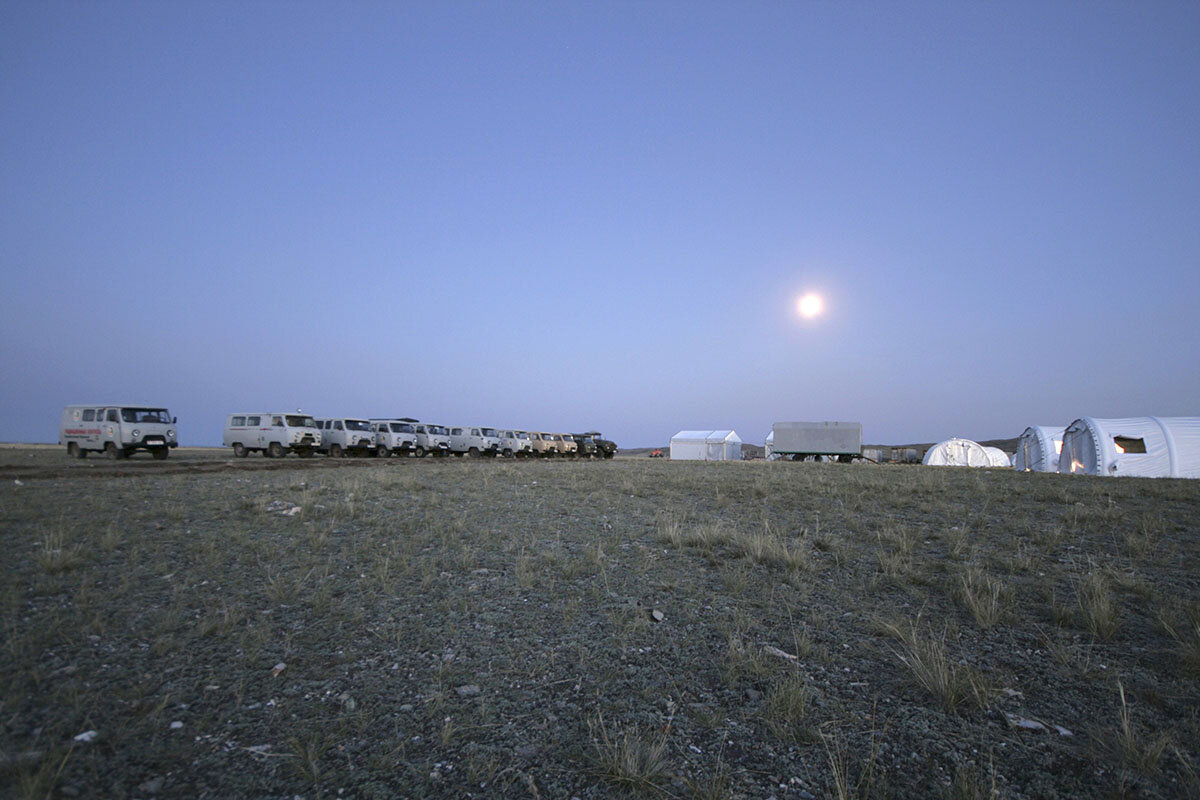
The argument for demonstratively detonating a nuclear weapon, perhaps in Ukraine or even Europe, was made explicitly last June by Sergei Karaganov, a top Russian strategic thinker, who published a profoundly controversial article suggesting Moscow should launch such a “pre-emptive nuclear strike.” The idea has sparked surprisingly little public conversation, but it has led to a sharp debate among strategic experts in Russia as well as in the West.
President Putin himself, however, does not appear convinced. At a security conference last month, he reminded Mr. Karaganov that Russia’s existing nuclear doctrine envisages the use of atomic weapons in only two instances – if another power has launched a nuclear attack on Russia, or if the existence of the Russian state is threatened by a conventional attack.
“Do we need to change this? Why would we?” said Mr. Putin. “There is no situation imaginable today where something would threaten Russian statehood and the existence of the Russian state. I do not think anyone in their right mind would consider using nuclear weapons against Russia.”
The risks of escalation
Mr. Karaganov’s thesis reflects Russian frustration at the long, costly, and painful ordeal of the Ukraine war, which they blame on the massive backing Ukraine has received from the united West. But critics warn that actually using a nuclear weapon, even if in a limited demonstration, risks an unpredictable response from the U.S., while probably losing Russia such sympathy and support as it has managed to garner from some countries of the Global South.
Even if the Ukraine war ends, global strategic stability is unlikely to be restored, analysts warn. The U.S. has sent signals to Moscow suggesting a limited resumption of talks on how to contain the dangers of nuclear war, or an accidental conflagration, but Russia has not reacted, says Fyodor Lukyanov, editor of Russia in Global Affairs, a leading Moscow-based foreign policy journal.
“I suppose this is not an acceptable approach for Russia,” he says. “Russia’s position is, let’s first address the serious problems that are causing discord, such as the war in Ukraine, security zones, NATO expansion, etc., and then pass on to the issue of strategic stability.”
Meanwhile, as the Ukraine war grinds on, the temperature continues to rise.
“Even now the U.S. continues to be against any possible peace negotiations, and sends ever more sophisticated weapons to Ukraine,” says Mr. Suslov. “We have sanctions that will never be repealed, U.S. pressure against us all around the world. And it will keep going on. That’s why, in the opinion of many in the Russian leadership and expert community, Karaganov’s logic is sound, even if his method would be counterproductive.”

Patterns
Biden wants to rebuild US clout. Gaza complicates that.
Here’s a different look at superpowers and responsibility. President Joe Biden is maintaining America’s historic support for Israel. But many nations crucial to American global influence want Israel to dial back its violent assault on Gaza. At a time when America’s global clout is already waning, Mr. Biden has tough choices ahead.

- Quick Read
- Deep Read ( 5 Min. )
When Russia invaded Ukraine last year, the overwhelming majority of United Nations members – standing by the United States – deplored Moscow’s aggression.
But last week, that overwhelming majority voted against Washington to insist that Israel should declare “a sustained humanitarian truce” in its brutal bombing of the Gaza Strip that has killed nearly 9,000 people, according to local authorities.
These doubts about U.S. support for Israel are straining coalitions that the U.S. president has been counting on to reassert American global leadership in the face of the rival ambitions of Russia, China, and Iran.
World attention is showing signs of shifting away from last month’s attack on Israel to focus more on the humanitarian crisis and civilian casualties in Gaza.
The Biden administration is not about to weaken its support for what it sees as Israel’s right to defend itself in the wake of the killing and abduction of hundreds of its civilians. But it is clearly aware of the diplomatic price it may pay for that support.
Joe Biden this week added his voice to calls for a “pause” in hostilities.
If the U.S. president can use his influence to ensure that humanitarian relief reaches the residents of Gaza, he will have greatly reinforced his bid to reassert his country’s global moral and political leadership.
Biden wants to rebuild US clout. Gaza complicates that.

Two wars, each with high stakes and painful costs, are together posing a critical test of President Joe Biden’s core foreign policy vision: a vigorous reassertion of America’s post-World War II role as global leader.
That’s because the political passions stirred by the wars in Ukraine and Gaza are threatening the support he will need to put that vision into practice.
Mr. Biden sees the catalysts for both conflicts – Russian President Vladimir Putin’s invasion of Ukraine, and Hamas’ Oct. 7 rampage through southern Israel – as a single challenge. “Hamas and Putin,” he declared in a rare Oval Office address on Oct. 19, “want to completely annihilate a neighboring democracy.”
But key political constituencies, at home and abroad, are not convinced about that parallel.
At home, bipartisan support for helping Israel remains strong. But with regard to Ukraine, it is fraying. A growing number of Republicans in the House of Representatives, echoing former President Donald Trump, question continued U.S. support for Kyiv. The newly elected House speaker, Mike Johnson, this week proposed a funding package limited to supporting Israel.
Mr. Biden may yet muster sufficient Republican support for Ukraine.
But abroad, the controversial issue is U.S. support for Israel. And that support is straining coalitions that the president has been counting on to reassert American leadership in the face of the rival ambitions of Russia, China, and Iran.
The first sign of this has come in the response of many countries in the Global South to Israel’s all-out bombing campaign against Hamas in Gaza, which has flattened large areas and killed nearly 9,000 people, according to figures from local authorities.

Last year, Washington was able to woo the overwhelming majority of those countries into opposing, or at least staying neutral toward, Russia’s Ukraine invasion. But now, most of them are defying the United States and demanding a cease-fire that Israel says would give Hamas fighters an advantage.
In March 2022, a mere handful of countries sided with Moscow against a United Nations General Assembly resolution deploring Russia’s invasion, while 141 nations stood with the U.S.
Last week, by 121 to 14, the same body voted in favor of a “sustained humanitarian truce” in Gaza, rejecting Washington’s insistence on an explicit condemnation of Hamas’ surprise attack and hostage-taking. The U.S. stood isolated, even from some of its European allies.
Mideast Turmoil: What’s Different This Time
Where does Israel’s pursuit of Hamas go next, and what does it mean for the broader Israeli-Palestinian struggle? Ned Temko, a veteran Mideast-watcher, joins host Clay Collins to talk about a region that demands command of context to cover – let alone analyze – fairly. Ned offers a high-altitude look at how this latest round of violence has, in a way, returned the Israeli-Palestinian conflict to its deepest roots – but also is focusing eyes on the importance of attempting some form of political resolution.
World attention is showing signs of shifting away from last month’s attack on Israel to focus more on the humanitarian crisis and civilian casualties in Gaza.
That has fed growing grassroots protests across the Arab and Muslim world and beyond. Bolivia this week severed diplomatic ties with Israel, while Chile and Colombia recalled their ambassadors.
Of most immediate concern in Washington will be its Arab allies – key to Mr. Biden’s hopes, dashed for now by the Israel-Hamas war, of securing a peace deal between Israel and Saudi Arabia as part of a regional bulwark against Iran.
These Arab states still see Iran as a shared threat, and last month’s brutal attack by Iran’s proxy, Hamas, has reinforced that view.
But in public, they have increasingly focused on the need for a humanitarian pause in the Gaza fighting, so as to protect civilians and get aid into the area. In the longer term, they are insisting – after years of Israeli government disinterest and international diplomatic neglect – on a return to serious efforts to secure a two-state peace deal between Israel and the Palestinian territories.
On Wednesday, Jordan – a longtime U.S. ally, formally at peace with Israel since 1994 – recalled its ambassador in protest over the “Israeli war on Gaza” and the “unprecedented humanitarian disaster” there.

The Biden administration is not about to weaken its support for what it sees as Israel’s right to defend itself in the wake of the killing and abduction of hundreds of its civilians. But it is clearly aware of the diplomatic price it may pay for that support.
In an interview with Foreign Policy magazine this week, Ehud Barak, the former Israeli prime minister and defense minister, predicted that “within a week or two we will probably lose the support of public opinion in many parts of the free world, and within another two or three weeks we might lose support of many of the governments in the free world. I think that America will still be with us, but it will be more and more complicated for them to stay behind us.”
To reduce such complications, Washington has been redoubling efforts this week to get large-scale aid deliveries to Palestinian civilians, and to establish a credible “safe zone” in the southern part of Gaza, so far without success.
And while sharing Israel’s view that a full cease-fire would leave Hamas strengthened politically, Mr. Biden this week called for a “pause” that would allow the release of hostages Hamas holds. U.S. Secretary of State Antony Blinken, arriving in Israel on Friday, was expected to push the government to arrange more such pauses for humanitarian purposes.
“American values are what make us a partner other nations want to work with,” Mr. Biden said in last month’s White House address. “American leadership is what holds the world together.”
If the U.S. president can use that strength to ensure that humanitarian relief reaches the residents of Gaza, he will have greatly reinforced his bid to reassert his country’s global moral and political leadership.

A deeper look
Southern, out, and electable: Gay politicians find success
Amid America’s culture wars, this is probably not a story you have heard much about. Gay politicians in the South are thriving, winning even in some of the deepest red districts. There is important nuance, but the trend shows how the narratives that drive so much of the nation’s political conversation don’t tell the whole story.

- Quick Read
- Deep Read ( 13 Min. )
-
Riley Robinson Staff photographer
Lesbian, gay, and bisexual politicians in the South are finding growing success. Most of them are out, but they don’t dwell on it, which means they feel empowered – but only to a point. Running for office requires the fortitude to be satisfied with an often-grudging acceptance.
Yet this acceptance also shows that the narrative of LGBTQ+ rights is more complicated than it is often portrayed. Buried deep in the Southern soul is not only a social archconservatism but also a sense of neighborliness and even accommodation that can help in dissolving barriers.
Laurens, South Carolina, demonstrates this complexity. It has long had a reputation as one of the most racist and homophobic corners of the United States. Until 2012, its downtown hosted the Redneck Shop, a Ku Klux Klan recruiting center.
Yet the mayor of Laurens, Nathan Senn, is a gay man.
“Mayor Senn didn’t run as an open person, but people knew,” says City Councilor Alicia Sullivan, who ran against and lost to him this spring. “He courted the town and won their hearts over from his work ethic. ... He’s a very complex person. He’s made history.”
That history-making explains a lot about how the rural South works.
As Jaime Harker, owner of the LGBTQ+ Violet Valley Bookstore in Water Valley, Mississippi, explains, “It’s easy to think there’s no queer culture [in the rural South]. ... If you only use Stonewall as the coming-out model of liberation, you’re not going to see anything here, ... but you are missing part of what’s happening.”
Southern, out, and electable: Gay politicians find success
When C.J. Green saw the apparently homeless stranger trudging up Georgia state Route 17, bowed by the weight of his rucksack, he thought, “He’s heading toward Midville.”
On his way to work later, Mr. Green, Midville’s chief of police, spotted and hailed the backpacker and listened to his story. Shirtless but not really homeless, 30-something National Guard member Ken Yasger was walking from his home near Tybee Island, Georgia, to Atlanta. It was the first leg of his journey to become the first openly gay governor of the state of Georgia.
Chief Green came away impressed – and feeling like a witness to history. Five days into a two-week trek, Mr. Yasger had slept next to a dumpster at a gas station – “homeless” with a $300 budget for a 300-mile trek. He’d gotten no sleep the previous night next to a church as rain drained into his nook.
“This is tractor and cow country – anyone wanting to get into politics should do what he is doing” to understand rural issues, Mr. Green says in an interview a few hours after the encounter. “It was really an honor to talk to the lowest man in Georgia seeking her highest office.”
Mr. Green wasn’t alone in coming to admire Mr. Yasger. Many concerned 911 phone calls about the tattooed stranger came from the same people who wound up leaving well wishes – 73 in all – on the town’s Facebook page.
Mr. Yasger’s path is unique, but his aim is increasingly plausible. While he remains the longest of long shots for the Georgia governorship, gay politicians in the South are finding growing success.
The trend is full of nuance. While the politicians winning elections are openly gay, most don’t dwell on it, which means they feel empowered – but only to a point. Running for office requires the fortitude to be satisfied with an often-grudging acceptance. Moreover, while that acceptance has begun cautiously to embrace the gay, lesbian, and bisexual community, it remains largely unavailable to transgender people.
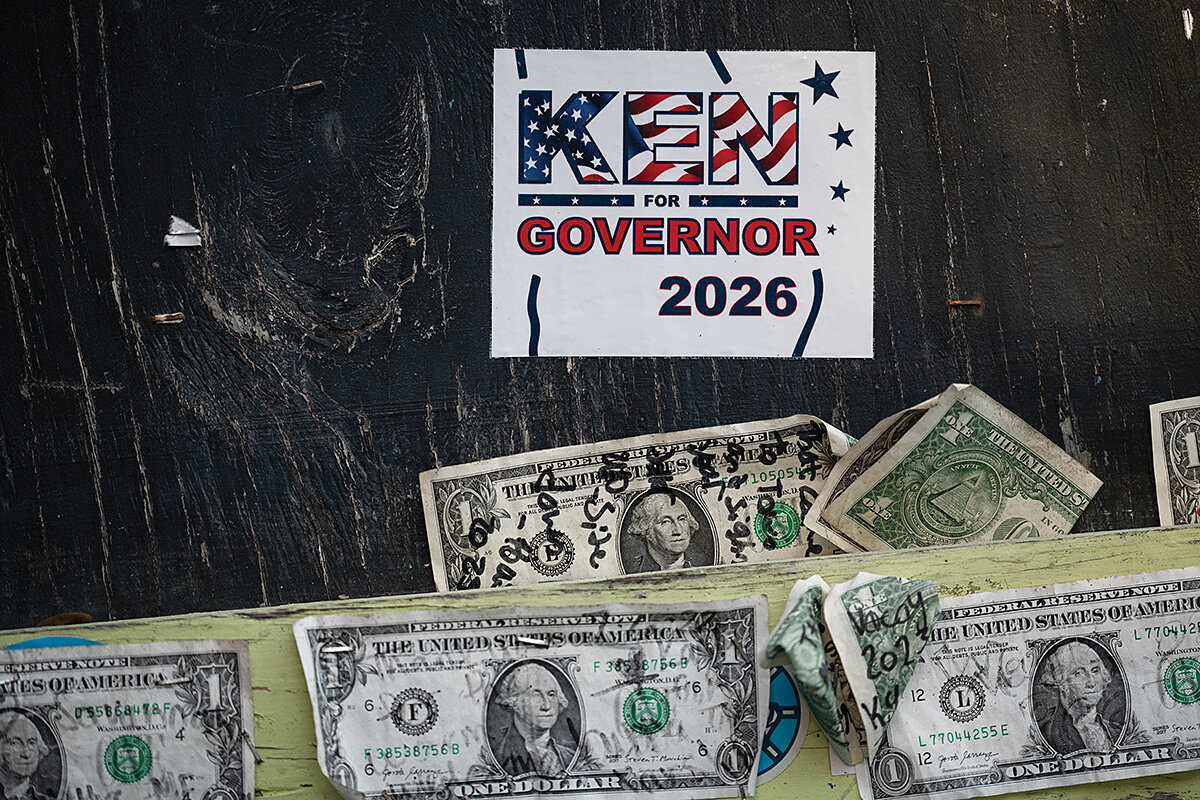
Yet this success also shows that – even in the most conservative small towns – the narrative of LGBTQ+ rights and same-sex marriage is more complicated than it is often portrayed. Buried deep in the Southern soul is not only a social archconservatism but also a sense of neighborliness and even accommodation that can help in dissolving barriers.
These politicians say there remains much work to be done, but they also say the South is changing, enabling them to live – and even thrive – in a way they would never have thought possible a generation ago.
“What you are seeing is how queer life has worked in the South, especially for those who are queer and interested in politics,” says Jaime Harker, a University of Mississippi English professor and owner of the LGBTQ+ Violet Valley Bookstore in Water Valley, Mississippi. “Yes, it can be a punching bag talking point for the Republican Party, but there’s also this whole idea of, ‘We like so-and-so, and he’s good at his job’ – where you wouldn’t talk about it, but you would know.
“You can call it hypocrisy,” she adds, “but it’s also a refusal to enforce the letter of the law that you are espousing so as not to harm an individual who is right in front of you. It’s about making accommodations for people you grew up with and who you love and who may not fit with whatever idea that’s being said officially. It gets at some of the interesting complexities of rural life in the South.”
As the aspiring governor Mr. Yasger takes a break next to a soybean field on Sept. 15, just north of Midville, he says, “I think, how many politicians are willing to do this for the people?
“This is ... the most physically grueling thing I’ve ever done in my life, ever,” the former Army Ranger adds.
And by that he includes the extra burden of his sexual orientation, which in much of the South remains on the books as illegal – even though a 2003 Supreme Court decision found anti-sodomy laws unconstitutional. So far this year, 83 anti-transgender bills have been passed across the United States, half of them in the South, according to Trans Legislation Tracker.
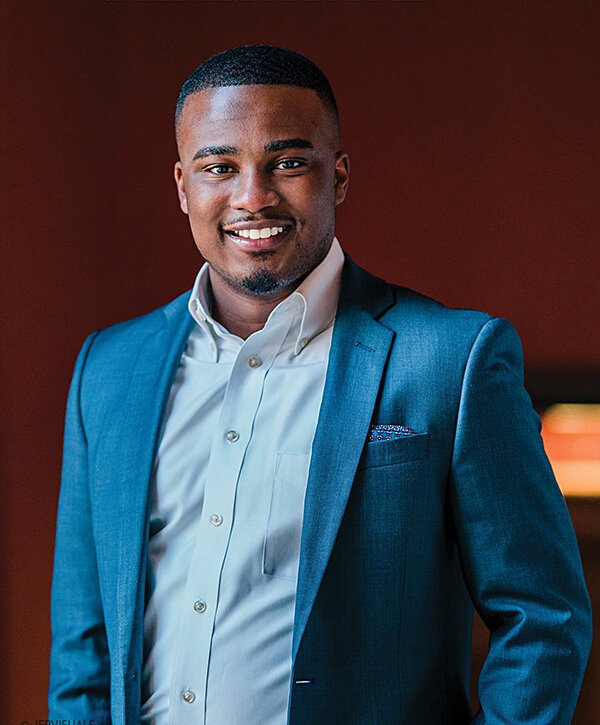
In his seminal book, “Men Like That,” John Howard traces how gay people in the rural South long had a tradition of what he calls “queer dissembling” – downplaying one’s authentic identity to accommodate local culture.
But that is “inappropriate, counterproductive, even harmful in the third millennium,” writes Dr. Howard, an emeritus professor of arts and humanities at King’s College London, in an email. The criminalization of consensual homosexual relations in the South, he adds, gave “legal sanction to other forms of anti-LGBTQ discrimination, from which we’ve yet to recover.”
Yet Mr. Yasger sees a crucial difference between what the law says and how today’s Southerners live their lives. The numbers back him up:
•Louisiana and Mississippi are the only states that have never elected an out LGBTQ+ person to the state legislature, according to Out for America 2023, a report by the LGBTQ+ Victory Institute, based in Washington. All other states, except Idaho and West Virginia, currently have at least one out LGBTQ+ state legislator.
•Voters in Nashville, Tennessee, elected Olivia Hill to the Metropolitan Council in September, making her the first transgender person elected to public office in the state.
•In 2019, Texas’ five LGBTQ+ lawmakers formed a caucus that has helped counter various anti-LGBTQ+ bills, including some during the 2023 legislative session, when 54 were introduced but only six passed, according to the American Civil Liberties Union.
•Texas state Rep. Julie Johnson has been a front-runner for the state’s 32nd U.S. Congressional District. If she wins, she’ll be the first openly lesbian member of Congress from Texas.
•In Louisiana, Davante Lewis last year became the first openly LGBTQ+ person elected to a state-level office on the Public Service Commission, which sets energy policy and electricity rates. Mr. Lewis upset a three-term incumbent to win.
For many of these politicians, navigating public acknowledgment of their sexual identity can be difficult. But they have found success in part by drawing on a Southern tradition of claiming one’s honor and independence.
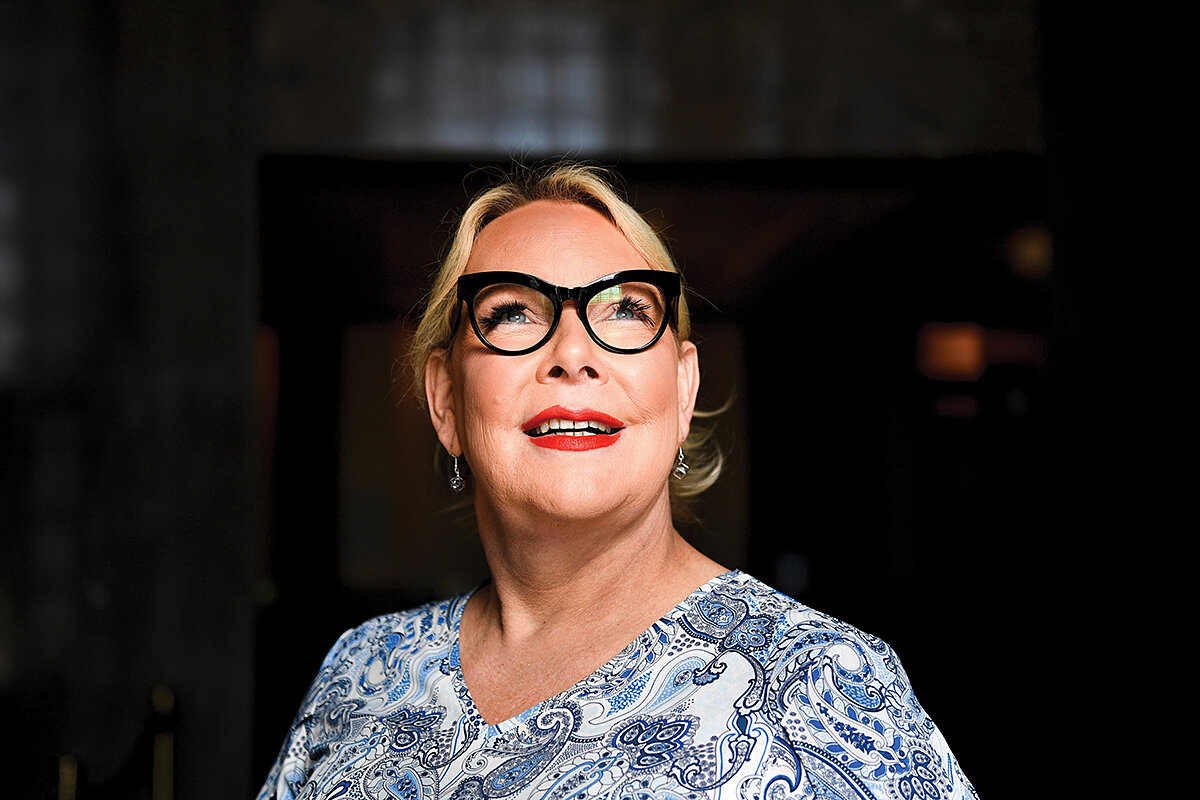
“The way [LGBTQ+ people in the rural South] see it is, ‘You’re going to have to push us off our land because we’re not going anywhere. We were born and raised here,’” says Darren Grem, an associate professor of history and Southern studies at the University of Mississippi near Oxford. “It’s a place where they thrive with a notable independent streak, in the sense of, ‘We’re here and present, and we have to put up with a whole lot of crap that folks in [more LGBTQ-friendly] communities don’t have to put up with.’ They’ve got a backbone that’s reinforced steel.”
Jason Elliott, a Republican, made South Carolina history in 2016 when he became the state’s first openly gay lawmaker. He represents the home district of archconservative, Christian Bob Jones University in Greenville.
Today, South Carolina has three openly LGBTQ+ elected politicians, including Gavin Smith, former press secretary for the Department of Labor in the Trump administration, who campaigned shoulder to shoulder with his husband to win a Town Council seat in Lexington earlier this year.
As Mr. Elliott knocked on doors during his first race, he harangued his primary opponent, an incumbent and graduate of Bob Jones University, for missing key votes at the Capitol. He won the primary with 58% of the vote and ran unopposed in the general election. His sexual orientation wasn’t part of the campaign, but he acknowledged later that it was one of the state’s worst-kept secrets.
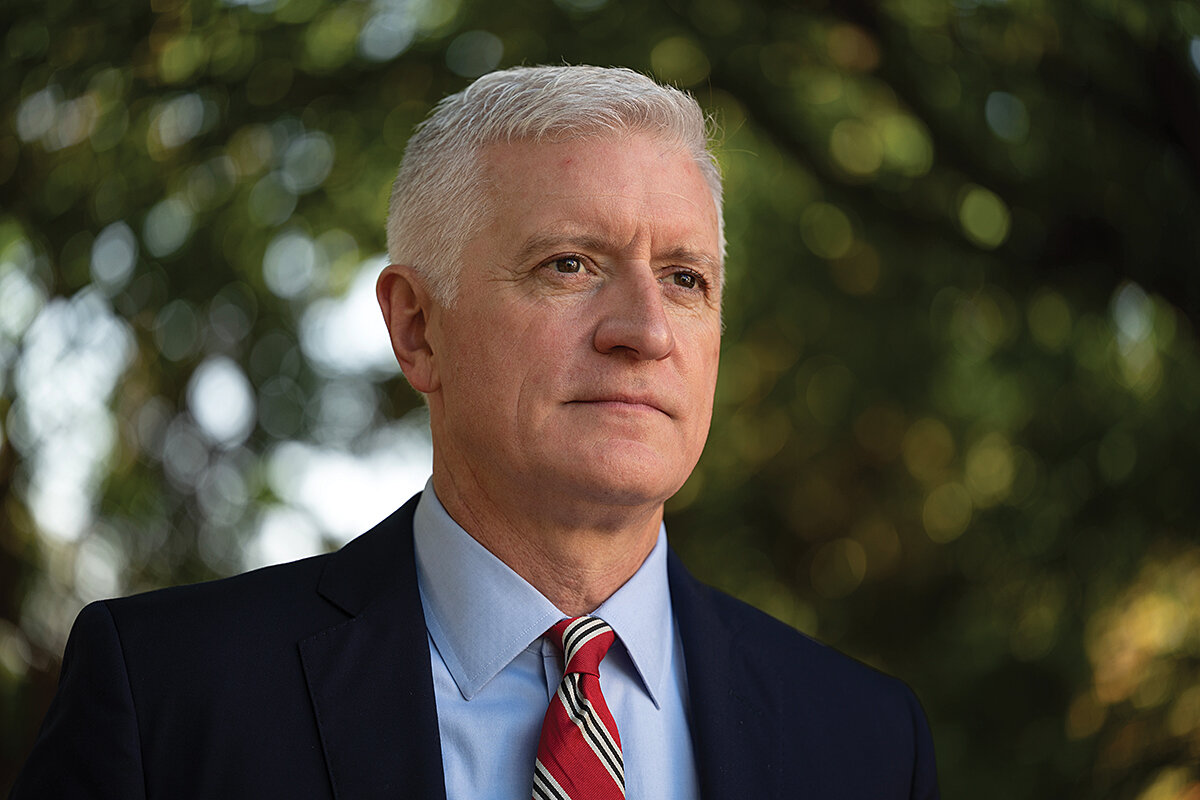
Still, his Republican primary challenger two years later suggested at one point that Mr. Elliot had misled voters about his sexuality and was morally out of step with the district. A newspaper article sketched his story after the primary opponent brought it up: Married and divorced with a grown son, Mr. Elliott had come out as gay.
“After your sexual orientation is on the front page of the paper, you feel like it was kind of liberating in a way,” Mr. Elliott says.
By the end of that campaign, the opponent had backed off his assertions, and Mr. Elliott went on to win – once again with 58% of the primary vote, and 63% against a Democrat in the general election.
He attributes his success partly to the more liberal-minded people moving into the state to work at its booming auto plants. But there has been a dramatic shift among Southerners, too, he argues.
Serving as president of the university in 1980, Bob Jones III said gay people should be stoned “as the Bible commands.” Later, as chancellor in 2015, Mr. Jones disavowed those comments and apologized for making them.
“I would say that most everyone in their life knows a person who is gay or lesbian, and being able to live authentically and to live into who you are, I think that changes a lot,” says Mr. Elliott. “And I hope that people see that, regardless of orientation, you have the same goals and hopes for yourself and your family and your community that all South Carolinians would have.”
Mr. Elliott has conservative viewpoints on abortion and transgender issues. He voted for the state’s Save Women’s Sports Act of 2022, which prevents transgender girls from competing in girls’ sports. He has seen connections with gay friends fade as a result of his politics. And he has found himself thinking deeply about not just policy but also empathy and acceptance.
“You don’t want to be heartless, and my mind may be changing” on transgender issues, he says. “For the folks who are truly dealing with that issue, ... I try to understand it; I try to be sympathetic. These are some of the most ostracized kids. I don’t want to pile on that. It’s a tough political issue.”
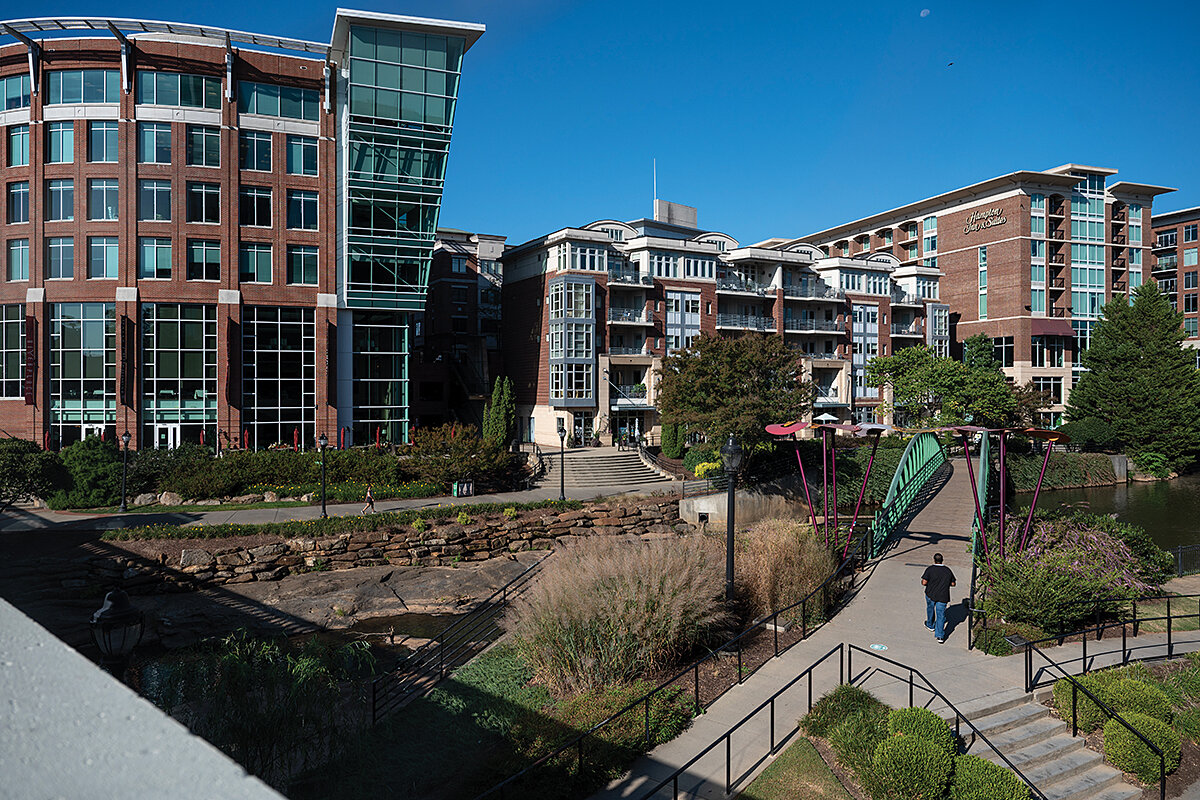
Laurens, South Carolina, demonstrates the complexity of LGBTQ+ life in the South. It has long had a reputation as one of the most racist and homophobic corners of the country. Until 2012, its downtown hosted the Redneck Shop, a Ku Klux Klan recruiting center.
More recently, state Sen. Danny Verdin, a Republican who represents Laurens County, sponsored a bill to ban gender-transition surgeries for those under age 21. Then, in July, a transgender 16-year-old was found dead by the side of the road after he moved out of his house following a fight with his mother. The changes Jacob Williamson made to affirm his gender as a man didn’t directly lead to his death, his friends have said, but his difficulty in finding love and friendship made him more vulnerable.
Yet the mayor of Laurens is a gay man.
Nathan Senn ran and narrowly won his first race in 2019 and was reelected by about a hundred votes this spring. His election biography doesn’t mention his sexual orientation. But his election made him the first openly gay mayor in the history of the Palmetto State.
“I’m a Clemson grad and a Tiger fan,” he writes in a campaign bio. “I like to paint. I’m curious. You’re more likely to find me watching a documentary than a movie and reading about theology or history rather than a novel.”
After leaving Laurens and graduating from college, Mr. Senn spent 10 years in comparatively liberal Charleston, where he founded his law firm. But he returned to Laurens because of a house he couldn’t get out of his mind – a faded and dirt-cheap antebellum mansion.

Upon his return, he discovered more of Laurens’ history, in large part by researching his house as he renovated it. A century ago, he explains, the mansion had belonged to a town attorney who, at the urging of local church leaders and the governor, prosecuted a mob that had lynched an innocent Black man.
Mr. Senn says he’s aiming to revive and re-brand the economically struggling city, not by ignoring past prejudice but by unearthing a more textured history that bucks the city’s reputation as “a racist backwater, which is not who we are,” he says.
Laurens has seen a remarkable uptick in business and interest from developers. The City Council’s main project this year is to make sure new housing fits the character of the area. The courthouse square buzzes with live music and the din of chatter on a Friday night. Acknowledging past wrongs, the city created a park in memory of a long-gone Black business district. A revived city festival features Piedmont blues, a distinct genre with a strong Black tradition forged in this region.
“There has to be intention to how we present ourselves to the world,” says Mr. Senn. “It’s important to be truthful about our challenges, but also to acknowledge that we are not alone in dealing with inequality and prejudice.”
But Jacob’s death was a difficult issue for the city. He had set up a date online and traveled to Monroe, North Carolina, to meet the person. Two people have been arrested in connection with his killing. If Jacob had been more accepted in Laurens, “he would have been less likely to try to find that love ... somewhere else,” Amberlyn Boiter told The Charlotte Observer this summer. Ms. Boiter is president of PFLAG Spartanburg, which supports and advocates for the LGBTQ+ community.
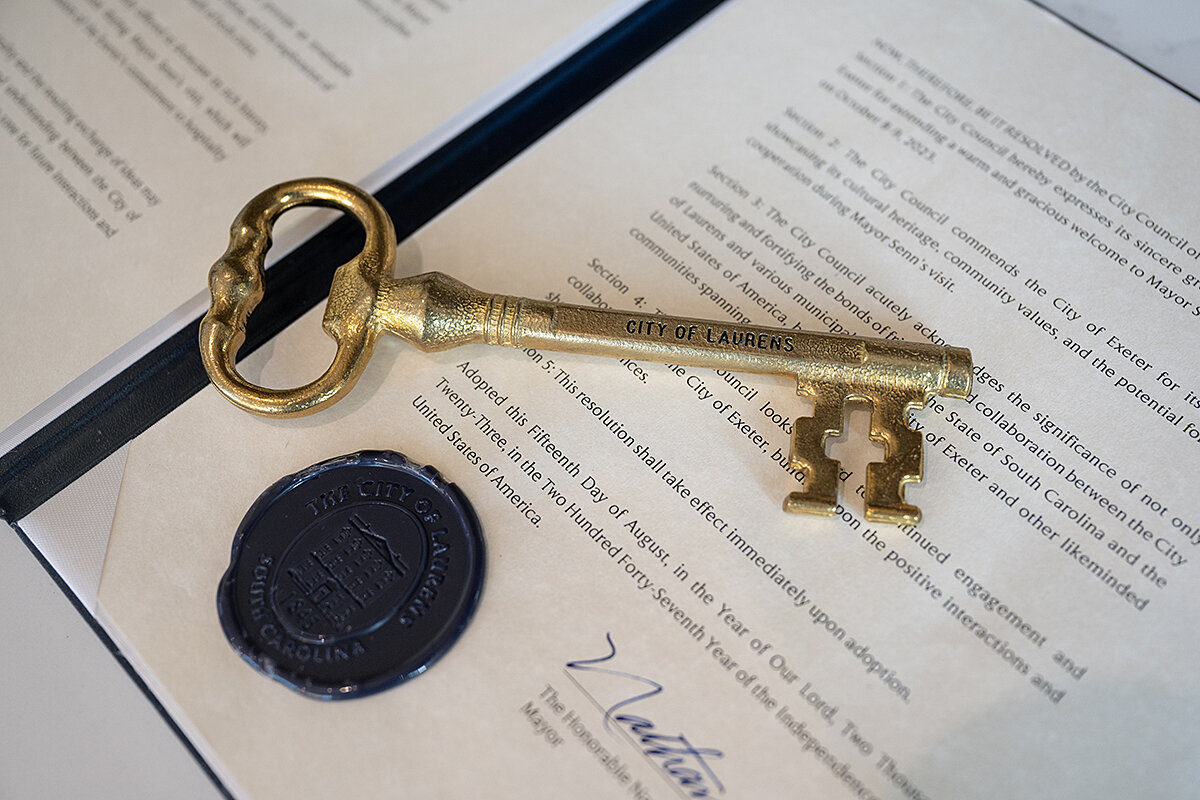
Mr. Senn was one of only two local officials to comment on the killing. And while he helped book a facility for a vigil, he did not attend. None of the politicians invited to the memorial showed up, organizers say.
City Councilor Alicia Sullivan, who ran against and lost to Mr. Senn this spring, brought up Jacob’s death during an interview with the Monitor.
“It’s a touchy subject, but at the end of the day, it’s about humanity, and I’m not interested in who the human is in love with,” she says. “My No. 1 focus is that we treat all humans with dignity and respect.”
That extends to Mr. Senn, with whom she has had political and personal differences.
“Mayor Senn didn’t run as an open person, but people knew,” she says. “He courted the town and won their hearts over from his work ethic. He had a lot of support from the African American community, and a lot of them are conservative and Christian. He’s a very complex person. He’s made history.”

That history-making explains a lot about how the rural South works. “If you come from a city and that is where you get to know gay culture, ... there are spaces that are visible that you can enter in,” explains Dr. Harker of Violet Valley Bookstore.
“In the rural South, there were none of those things. So it’s easy to think there’s no queer culture. ... If you only use Stonewall as the coming-out model of liberation, you’re not going to see anything here, ... but you are missing part of what’s happening,” she adds.
Walking outside Midville, Mr. Yasger understands the struggle over how much to emphasize one’s orientation – and define one’s place.
Mr. Yasger doesn’t lead with, “I’m gay.” In fact, it’s the last bit of his elevator pitch, after marijuana legalization, his focus on compromise, and opposition to “cultists” on both the left and the right.
His path hasn’t been easy. Mr. Yasger was one of the only openly gay soldiers in his Army Ranger platoon. He once made national news for inviting the singer Katy Perry to his Ranger Ball – which she politely declined through a manager. But his dream has long been to run for office as a Republican.

“When I came out, being a gay Republican wasn’t a thing,” says Mr. Yasger. “I knew that if I wanted to be involved, I was just going to be one of those in-the-closet Republicans like everybody else was. Now it’s a lot more accepted.”
He ran for a state Senate seat last year and lost by 900 votes against a strong incumbent. In other words, he wasn’t ignored by hardcore Georgia primary voters.
That may partly be due to his experience navigating a conservative world as an openly gay soldier. In large part, his strategy has been to look for commonalities over differences and to hold firm on compromise, whether pressure is coming from the right or the left.
“I’m not trying to keep Georgia red or stop Georgia from turning blue – I want us to be red, white, and blue,” says Mr. Yasger, hoisting his rucksack onto his back to continue his quest. “People are tired of division. I want Georgia to be an example of what a united state can be.”

The Explainer
What California’s climate diplomacy with China achieves
We often think of climate action as huge or tiny – countries wrestling with monumental laws or you deciding how to sort your trash. But maybe that’s the wrong way to look at it. Maybe climate action is a web of connections, from towns to businesses to nations. And maybe states can play a role, too. California certainly thinks so.

- Quick Read
- Deep Read ( 5 Min. )
-
Ann Scott Tyson Staff writer
California Gov. Gavin Newsom’s recently completed trip to China symbolized the way diplomacy at the level of states or regions can be a path to climate progress.
Some analysts see a bit of political theater, too, for a politician viewed as having presidential aspirations. But the trip resulted in a number of climate announcements, including an updated agreement to work aggressively toward carbon neutrality.
This California relationship with counterparts in China has evolved over many years into an example of how steady gains can come as governments find common ground for actions, from trading knowledge to making pledges on shared ambitions.
“Some of the geopolitics that puts stress on the U.S.-China relationship can be put to one side when California and China work together on climate policy and climate technologies,” says Dan Lashof, U.S. director of the World Resources Institute.
California has been working directly with China for years on climate policy. Several of China’s provinces have copied California’s cap-and-trade program for industrial emissions. California is looking to China for its expertise on offshore wind energy.
“There’s this not very glamorous but very important work going on in California and in China,” says Mary Nichols, vice chair of the California-China Climate Institute.
What California’s climate diplomacy with China achieves
California Gov. Gavin Newsom’s recently completed trip to China symbolized the way diplomacy at the subnational level – involving regional, state, or local governments – can be a path to climate progress.
Some analysts see a bit of political theater, too, for a politician viewed as having presidential aspirations. But the trip resulted in a number of climate announcements, including an updated agreement to work aggressively toward carbon neutrality.
This California relationship with counterparts in China has evolved over many years into an example of how steady gains can come as governments find common ground for actions, from trading knowledge to making pledges on shared ambitions.
“Some of the geopolitics that puts stress on the U.S.-China relationship can be put to one side when California and China work together on climate policy and climate technologies,” says Dan Lashof, U.S. director of the World Resources Institute.
The United States and China, together, represent about 40% of the world’s greenhouse gas emissions. “We’re not going to move the needle on climate change unless the United States and China collaborate,” said Governor Newsom while in Beijing last week. On the necessity of California working directly with China, he added, “No other state has benefited more from the contributions of Chinese [people]. No other state is more burdened if we can’t work together to address and reconcile whatever differences we have.”
What has California achieved with China on climate issues?
During his trip, Mr. Newsom’s office inked five nonbinding agreements with the Chinese national government and several provinces and cities. Those include commitments to focus on:
- Industrial decarbonization and reducing short-lived pollutants, like methane, with Guangdong province.
- Clean energy deployment, especially offshore wind, with Jiangsu province.
- Climate adaptation, including flood preparation, with Beijing.
- Decarbonization of the transportation sector and development of a trans-Pacific green shipping corridor with Shanghai.
- Zero-emission vehicles, carbon markets, and climate finance with the Chinese national government.
The agreements build upon past relationships. California has been working directly with China for years on climate policy. Mr. Newsom is the third consecutive California governor to visit China.
For instance, several of China’s provinces have copied California’s cap-and-trade program for industrial emissions. In 2014, China’s national government adopted California’s zero-emission vehicle credit trading system, partly as a way to phase out China’s subsidies of the electric vehicle industry.
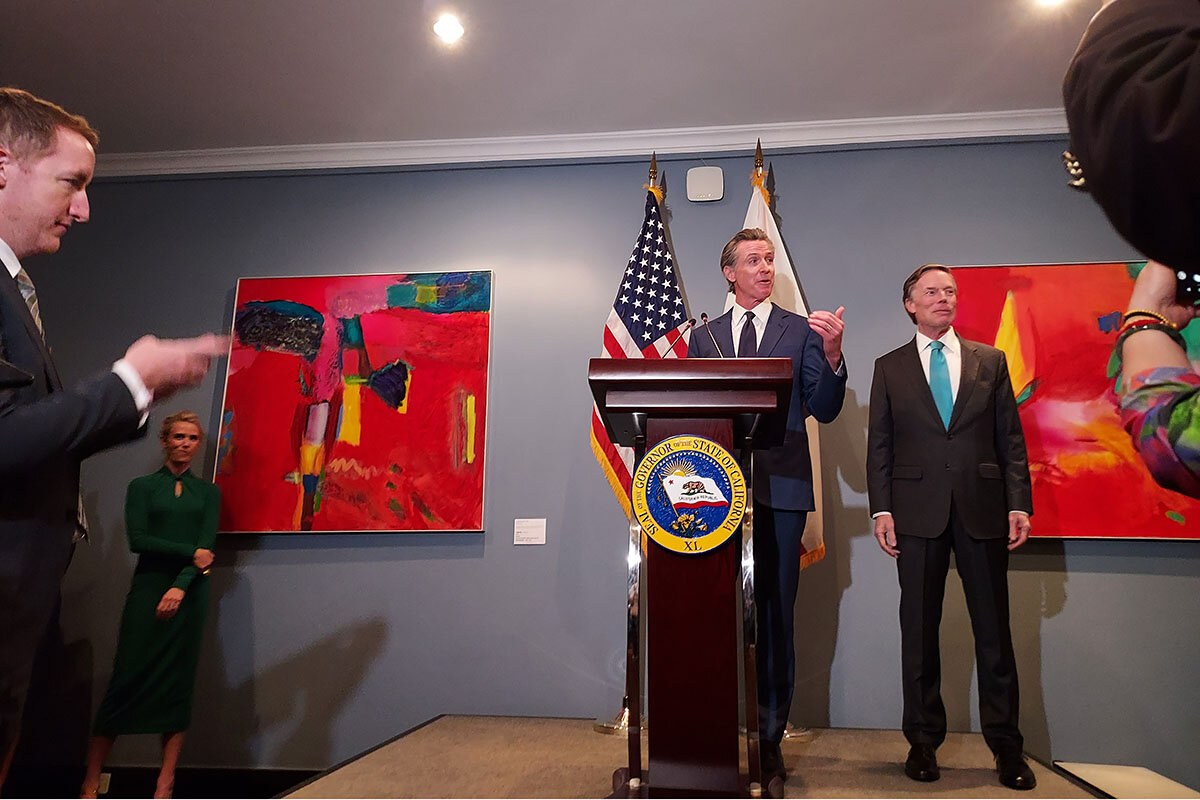
On offshore wind energy, California is looking to China for its expertise. “California is very interested in developing offshore wind,” says Dr. Lashof. “China is ahead in actually doing that. And they have more wind capacity than any place in the world. So there is an opportunity to learn as well as to teach.”
California and China have lots of reasons to get along: Nearly a third of Chinese immigrants to the United States live in California. China is the world’s second-largest economy; California is the world’s fifth-largest economy if it were measured like a country – and both economies are technologically advanced.
The California-China relationship has also nudged China toward greater transparency through shared goals, research, and data, according to Mary Nichols, vice chair of the California-China Climate Institute.
How important is climate diplomacy between U.S. entities and China?
China is by far the world’s largest greenhouse gas emitter. And the U.S. comes in second. Efforts at cooperation make a difference – even if incremental.
“There’s this not very glamorous but very important work going on in California and in China,” says Dr. Nichols. “I think people should know about it and at least take some comfort in the fact that there’s a lot of resources, a lot of talent going into working to try to get on top of this problem faster and more effectively than ever before.”
One example of how the efforts have reduced greenhouse gas emissions: The city of Beijing’s air regulations, modeled on California’s, achieved a 95% drop in coal consumption there, according to Governor Newsom’s office.
A stumbling block in the relationship is how China, despite its climate goals, continues to build new coal-powered plants elsewhere.
California is also increasingly reliant on China for batteries in order for the state to meet its electric vehicle goals. Yet American critics of climate diplomacy deride the risk associated with depending on China and relinquishing battery production.
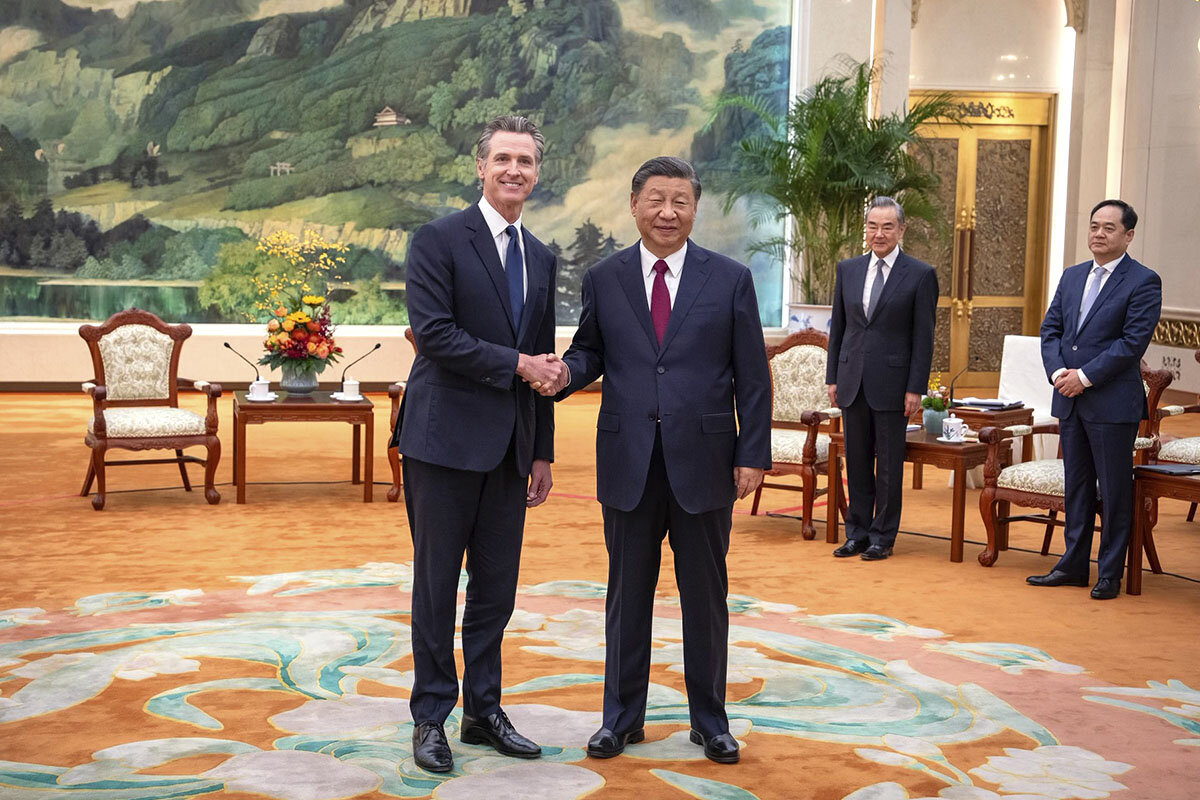
What are other examples of subnational collaborations on climate?
Subnational collaborations are not new. Global organizations exist like the Under2 Coalition, a group co-founded by the California state government in 2015 and made up of over 270 states, regions, and other entities around the world that together account for more than half of the global gross domestic product. This group aims for net-zero carbon emissions by 2050.
C40 is another coalition made up of nearly 100 cities – including Abidjian, Cape Town, Hong Kong, Los Angeles, and Oslo. Membership requires cities to make demonstrable progress toward climate goals aligned with the Paris Agreement.
A 2020 report by the World Resources Institute and the United Nations recognizes the increasing importance of subnational relationships in crafting effective climate policies and implementing those policies at the local level. And last year, the U.S. State Department created a Subnational Diplomacy Unit to support global relationships with state, city, and local leaders.
How impactful are these efforts?
Subnational cooperation on climate change has remained relatively steady while cooperation among nations has not. President Barack Obama reached some key climate agreements with Chinese leader Xi Jinping in 2014, paving the way for the Paris climate agreement the following year. The U.S. withdrew from global climate cooperation under President Donald Trump and then recommitted to the Paris Agreement under President Joe Biden. China temporarily halted climate discussions with the U.S. last year after then-House Speaker Nancy Pelosi visited Taiwan.
“U.S. federal policy on climate has been very inconsistent from administration to administration,” says Dr. Lashof. “California has had a much steadier progress on climate that really hasn’t been interrupted.”
That doesn’t mean subnational ties are immune from turmoil. A 2015 sister-city partnership between San Francisco and Xiamen has since been suspended because of issues between their two countries, according to Cai Biling, a program officer at the Ministry of Natural Resources in Beijing.
Ms. Cai says she hopes the program for marine litter prevention and control can be restored, and that action on climate change “starts with every community and the people. ... The government ... can just lay the framework, but to put it into real action, we need our cities and our people.”
The relationship between China and the U.S. in 2023 is tense – complicated by concerns on both sides about trade, technology, and Taiwan.
That tension in U.S.-China relations is plain to people in the business community, too. “Right now ... at the national level, it’s almost frozen. ... Both countries cannot afford to be that hostile,” says Wayne Song, founder and CEO of C4X and Green Carbon Nanotech, based in Suzhou, China.
Dr. Song believes subnational success can help thaw frosty relations higher up. “I think this kind of local conversation ... is raising the temperature a little bit so the ice will melt.”
Other headline stories we’re watching
(Get live updates throughout the day.)The Monitor's View
For Palestinians in Gaza, a coming choice
- Quick Read
- Deep Read ( 2 Min. )
-
By the Monitor's Editorial Board
A new survey of 173 countries might be a helpful guide for the coming decision on who will rule the Gaza Strip if Israel’s military takes over the enclave of 2 million Palestinians. While the survey confirms a steady decline in democracy worldwide, it also notes a countervailing trend in a number of places where citizens have lately achieved lower levels of corruption.
For Palestinians in Gaza, such a hopeful sign of the irrepressible desire for clean governance could be a starting point in creating a new democracy.
Polls bear this out. Just months before the Oct. 7 attack on Israel by Hamas, an opinion survey found that 73% of Gaza residents believed the Hamas government to be corrupt. “The vast majority of Gazans have been frustrated with the armed group’s ineffective governance as they endure extreme economic hardship,” wrote Amaney Jamal and Michael Robbins, scholars at Princeton University, in Foreign Affairs last month.
Palestinians in Gaza can begin to prepare for the building of a resilient state that commands both legitimacy and accountability.
For Palestinians in Gaza, a coming choice

A new survey of 173 countries might be a helpful guide for the coming decision on who will rule the Gaza Strip if Israel’s military takes over the enclave of 2 million Palestinians. While the survey, by a Sweden-based think tank, confirms a steady decline in democracy worldwide, it also notes a countervailing trend – or “green shoots” – in a number of places where citizens have lately achieved lower levels of corruption.
For Palestinians in Gaza, such a hopeful sign of the irrepressible desire for clean governance could be a starting point in creating a new democracy.
Polls bear this out. Just months before the Oct. 7 attack on Israel by Hamas, an opinion survey found that 73% of Gaza residents believed the Hamas government to be corrupt. And that percentage had been rising, which may help explain one possible reason why the Islamist group launched the attack on Israeli civilians to provoke a response. After previous conflicts with Israel, Hamas’ popularity rose, even if temporarily, until Palestinians in Gaza again noticed corruption in their public institutions.
A poll of Gaza residents earlier this year, done by the Palestinian Center for Policy and Survey Research, found that 25% saw corruption as the first problem in their society. That is behind only the 38% who said the establishment of a Palestinian state should be the first goal.
“The vast majority of Gazans have been frustrated with the armed group’s ineffective governance as they endure extreme economic hardship. Most Gazans do not align themselves with Hamas’s ideology,” wrote Amaney Jamal and Michael Robbins, scholars at Princeton University, in Foreign Affairs last month.
The global survey on democracy, conducted by the International Institute for Democracy and Electoral Assistance, found anti-corruption efforts increasing in countries as diverse as Zambia and Ukraine. Much of that progress comes from informal actors who provide checks and balances on government, such as journalists, election organizers, and anti-graft activists.
Since the approval in 2003 of the United Nations Convention Against Corruption, the world has “united around a common vision for integrity, transparency, and accountability,” Ghada Waly, executive director of the U.N. Office on Drugs and Crime, said last month. Those qualities, she added, “are essential safeguards to protect the values of democracy, preserve the rights of everyone, and prevent breakdowns in the rule of law.”
Palestinians in Gaza, too, can rely on such safeguards to build a resilient state that commands both legitimacy and accountability.

A Christian Science Perspective
Each weekday, the Monitor includes one clearly labeled religious article offering spiritual insight on contemporary issues, including the news. The publication – in its various forms – is produced for anyone who cares about the progress of the human endeavor around the world and seeks news reported with compassion, intelligence, and an essentially constructive lens. For many, that caring has religious roots. For many, it does not. The Monitor has always embraced both audiences. The Monitor is owned by a church – The First Church of Christ, Scientist, in Boston – whose founder was concerned with both the state of the world and the quality of available news.
The real heaven and earth
- Quick Read
- Read or Listen ( 4 Min. )
-
By Warren Berckmann
Like biblical figures that came before us, we can progressively experience our God-given harmony and wholeness.
The real heaven and earth
John, whose revelation is recorded in the last book of the Bible, lived in a time that, like ours, had a plethora of problems. Yet he saw a promise of harmony based on the recognition of God, good, as the cause of all that really is. He followed Christ Jesus, who said, “I am the way, the truth, and the life” (John 14:6). Doesn’t this indicate that through a more spiritual, Christly way of thinking and living, this promise is available to all right now?
Innumerable examples in the Bible show that there is no human circumstance that God’s infinite love and power cannot correct and heal. “Science and Health with Key to the Scriptures” by Mary Baker Eddy, the Discoverer and Founder of Christian Science, explains, “It is our ignorance of God, the divine Principle, which produces apparent discord, and the right understanding of Him restores harmony” (p. 390).
A seemingly endless succession of recent calamities has left many gripped by fear and despair. Underlying those emotions are two theories: that creation is flawed and includes evil and that evil events can strike anyone, anytime, anywhere. One might even be persuaded that evil is superior to good.
However, the Bible presents an entirely different perspective. John’s revelation in particular offers a spiritual vision of harmony right where the physical senses report suffering: “I saw a new heaven and a new earth: for the first heaven and the first earth were passed away; ... And I heard a great voice out of heaven saying, Behold, the tabernacle of God is with men, and he will dwell with them, and they shall be his people, and God himself shall be with them, and be their God. And God shall wipe away all tears from their eyes; and there shall be no more death, neither sorrow, nor crying, neither shall there be any more pain: for the former things are passed away” (Revelation 21:1, 3, 4).
Christian Science teaches that by understanding God, we can experience the deliverance that biblical characters did. We can be profoundly persuaded that nothing can separate us from God’s love (see Romans 8:38, 39).
What begins to dawn in consciousness as we progressively feel this inseparability from God, good, is a reorientation of thought. What appears as a material universe governed by material laws becomes better understood as the “new heaven” and “new earth” governed by divine law. This is the real heaven and earth of God’s creating.
What John saw, we can also experience. The apostle’s corporeal sense of heaven and earth had given way to a spiritual sense. This encourages us to look beyond material explanations and predictions and rely on the spiritual understanding of God’s universe and its everlasting spiritual perfection. It assures us that we can expect good, not evil, and see it expressed in our individual lives, in our communities and countries, and in the world.
We don’t pray to fix an imperfect creation, but to see the present perfection of God’s creation. Relying on divine laws, we can overcome what appear to be material laws of inharmony and their effects. This reliance, based on spiritual understanding, never ignores human conditions, but causes the real heaven and earth, God-given health and goodness, to be experienced to a greater and greater degree in our lives.
At one time I suffered from severe back pain. The prognosis seemed bleak. However, I had experienced many healings through prayer alone, so I continued to pray with an understanding trust in God as all-powerful, ever-present good.
One day, I was studying the biblical account of Shadrach, Meshach, and Abednego, who had been threatened with death by fire if they would not bow down to the Babylonian king’s idol (see Daniel, chap. 3). I was suddenly struck by their faith. They told the king, “We will not serve thy gods.” And although they were put into the fire, they were not harmed by it.
I realized that I, too, could trust God entirely and not bow down to the idols of fear and belief in material laws. Within a week, my back was completely, permanently restored to normality.
Because divine law is supreme, invariable, and harmonious, each of us, following what Christ Jesus taught and demonstrated, can confidently and fearlessly face down evil and prove the real heaven and the real earth to be entirely good, right where we are. As Jesus said, “In the world ye shall have tribulation: but be of good cheer; I have overcome the world” (John 16:33).
Adapted from an editorial published in the Nov. 1, 2021, issue of the Christian Science Sentinel.

Viewfinder
Golden touch

A look ahead
We’re glad you spent time with us today. If you’re confused about the short intro or the long editor’s notes above every quick read, just look at yesterday’s Daily issue, where we explained some experimentation we’re doing this month.
For tomorrow, we’re planning a graphics story that looks at the rise of antisemitism worldwide – a trend that always bears watching, but particularly during the heightened tensions of the Israel-Hamas war.


